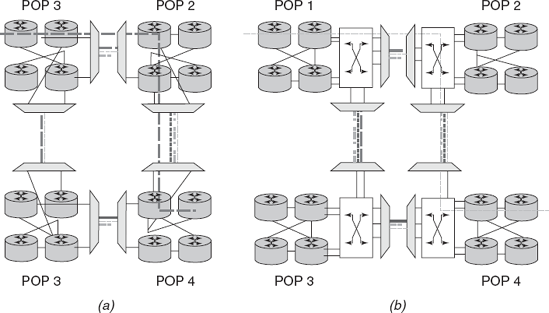10.4. SWITCHED OPTICAL BACKBONE
With IP traffic continuing to grow at a healthy rate [4], scalability of IP backbones is one important problem, if not the most important, facing service providers today. Historically, IP backbones have consisted of core routers interconnected in a mesh topology over ATM or SONET/ SDH links. With the advent of WDM technology, service providers are now connecting core routers directly over point-to-point WDM links. This architecture, referred to as IP over WDM, is illustrated in Figure 10.15a [4]. Figure 10.15 shows an IP traffic flow from point of presence (PoP) 1 to PoP 4 passing through PoP 2 as an intermediate Pop [4].[]
[] Transit traffic at PoP 2 (for this IP flow) uses IP router ports. In IP over WDM, traditional transport functions such as switching, grooming, configuration, and restoration are eliminated from the SONET/SDH layer. These functions are moved to the IP layer and accomplished by protocols like MPLS [4].
Figure 10.15. Alternative architectures for interconnecting IP routers: (a) lP over WDM and (b) IP over OTN.

In an alternative approach, referred to as IP over OTN, routers are connected through a reconfigurable optical backbone, or OTN, consisting of SONET/SDH OXCs interconnected in a mesh topology using WDM links. The core optical backbone consisting of such OXCs takes over the functions of switching, grooming, and restoration ...
Get Optical Networking Best Practices Handbook now with the O’Reilly learning platform.
O’Reilly members experience books, live events, courses curated by job role, and more from O’Reilly and nearly 200 top publishers.

